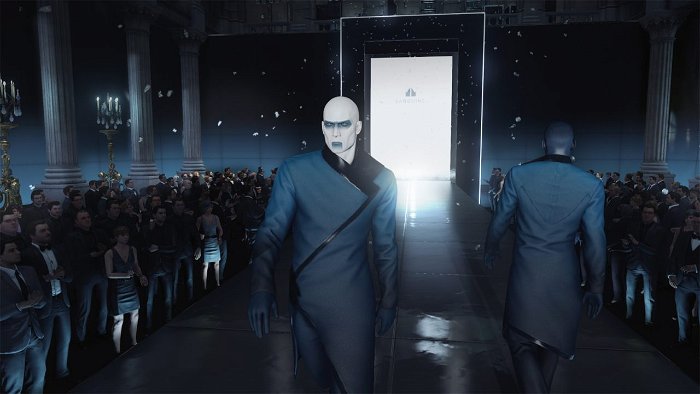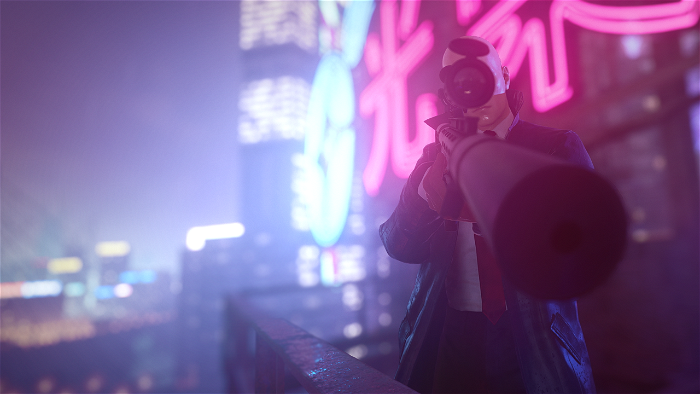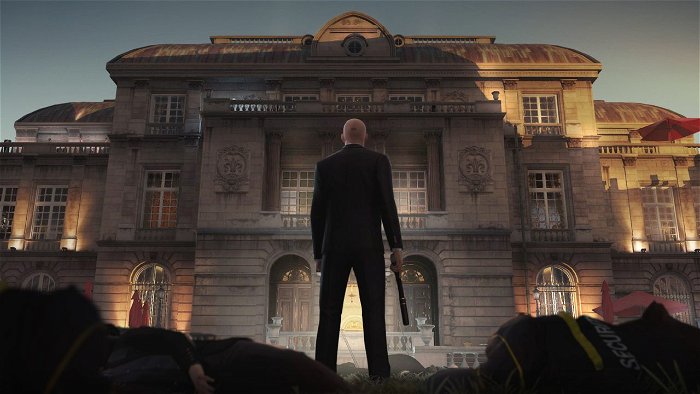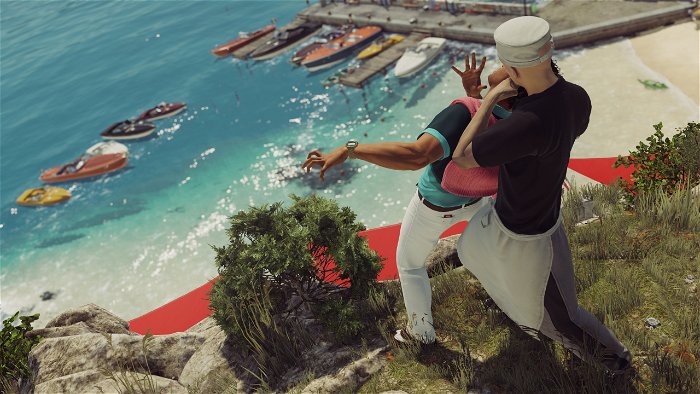The target is Sierra Knox, the wealthy daughter of the CEO of a technology conglomerate. She’s racing a state of the art car in Miami, and there are a multitude of ways to assassinate her. You could sabotage the car, plant explosives on the track, rig the pyrotechnics display at the podium, or even simply grab a sniper rifle and do the job the old fashioned way. The point is, the methods to kill Sierra are diverse and varied.
Yet my favourite remains dressing up in a pink flamingo costume and pretending to be a blackmailer to get close to her. Because it showcases the two things that define Hitman’s World of Assassination Trilogy; the depth of its level design, and its commitment to absurdity.

Last week, Hitman 3 closed out IO Interactive’s soft reboot of its biggest franchise with a bang. Across five years, the three games that make up the World of Assassination trilogy have featured some of the most elegant game design in the stealth genre in recent memory. And I have no doubt that the lessons IO Interactive learned while making Hitman will carry over to Project 007, a licensed property that plays directly to the studio’s strengths.
IO Interactive’s previous games never caught my attention in the way that its newest trilogy did. Yet Hitman was my Game of the Year for 2016, Hitman 2 was on my list of top five games for 2018, and it wouldn’t surprise me if Hitman 3 made an appearance on this year’s list as well. So as I sit at home, preparing to carve my way through its levels once again (And maybe play through some of the older levels as well), the more I think about what exactly draws me towards this World of Assassination. Because saying its level design and sense of humour are good doesn’t quite cut it.
Hitman’s story certainly isn’t commanding on its own. Agent 47 is a blank figure by design, with only a small number of personality traits and even fewer facial expressions. The trilogy’s story, involving conspiracies and counter-conspiracies featuring the world’s elite, is a serviceable narrative that is ever present in the background. It reminds of 2016’s DOOM, where the story is clearly not anything special nor a reason in and of itself to play the game, yet it is surprisingly competent and visible enough that it provides a nice flavour to the proceedings.

The real star of the show is Hitman’s levels. To varying degrees, each are open worlds that enable you to take a myriad number of approaches to assassinating your targets. There are guided mission stories that take you through particularly notable ways to kill or access someone, but there are also dozens upon dozens of interactable tools that can be used to your advantage. Some are expansive, such as Hitman’s beloved Italian town of Sapienza, while others are built vertically with tougher locks to crack, such as Hitman 2’s Isle of Sgàil. Regardless of how they are structured, each is filled with opportunities for any assassin to take advantage of.
The level design has been compared by many, including myself, to be like a Rube Goldberg machine. But you’re not exactly solving the machine — it’s already running just fine without your input, with NPCs going about their routines — it’s more like you’re breaking it. Each interaction, each disguise, each tool, are all means by which the player can take a wrench to the machine, knock out some parts, and see how the world reacts. Maybe it will end in failure, maybe it will open up something new. Either way, it will cause chaos.
Except the tools in any given Hitman level are inflexible in nature. Be they an aspect of the environment the player can interact with or an object they either find in a mission or bring with them, each only has a limited number of uses. Rat poison sends someone rushing to the nearest bathroom. A lead pipe is going to be used to knock someone out. A fire alarm causes evacuations and instigates searches by nearby guards. A coin causes people to stop behaving like human beings and search for it at all cost. And explosives… explode. Compared to other stealth games, such as Dishonored, which offer a small number of tools that are highly flexible, Hitman offers hundreds that often only have one or two applications.

That may sound like a weakness, but Hitman’s structure turns it into a strength. The aforementioned mission stories are great for first time playthroughs of a level, but Hitman is designed to be replayed. It encourages you to dive into levels again and again in order to scope things out and learn how to approach assassinations without relying on the game to tell you what to do. And it is through that repetition that you begin to see that the previously inflexible tools actually collide and work together in interesting ways. Watch a target for long enough and you’ll know exactly how to get them scurrying over to a bar, whereby you can inject some lethal poison into their drink. And that may require knocking out multiple guards, moving in the correct way while utilizing distractions, and more broadly using those inflexible tools with precision.
However, when a level or objective is constrained by design, that inflexibility becomes limiting. This is most apparent in objectives which do not involve killing targets. Going back to Sapienza, Agent 47 must destroy a virus sample in addition to the requisite killing of two targets. The virus sample is always in the same location, ultimately requiring the same approach to access and destroy. In a game designed for replayability and exploration, it’s a black mark.
And yet that example pales in comparison to the disappointment of the trilogy’s grand finale in Romania. The final mission is set on a train, a linear journey from one end to the other that features little opportunities to do anything besides press forward and scavenge for tools. It is satisfying only on two fronts: from a narrative standpoint, considering it brings the overarching plot to a close, and from its difficulty, as it requires a lot of hard work to get through it unnoticed. But neither of those options are what Hitman truly excels at, and so the trilogy ends on its weakest mission.

Also lost in the ending is something that’s been ever present since 2016’s Hitman — a sense of humour. Comedy is subjective, and comedy in video games is difficult to pull off, let alone emphasize. Yet Hitman manages to be one of the funniest games around precisely because it doesn’t put its jokes front and center. Much like the level design, it builds and grows across each level the more you play it.
It’s easy to see how Hitman is a farce just by looking for opportunities. The classic example of this is Helmut Kruger, a model who looks identical to Agent 47 and whom you can disguise yourself as to infiltrate a fashion show in Paris; 47 fabulously striking a pose on the runway might just be the moment where I fell in love with this trilogy. In Miami, you get the ridiculous flamingo costume by knocking out the man wearing it; except, if you stop and listen to the phone call he’s on, you learn that he knocked out the original wearer of the costume and has now lost his car keys. And in Dubai, you can discover that one maintenance worker has anger management issues and has made an explosive golf ball to kill her boss.
But it’s not just the fact that there are crazy things happening that make the World of Assassination funny. It’s the fact that you uncover that humour by engaging repeatedly with the game’s levels. In learning how each location operates, you learn how to pull off more and more absurd kills because you grow your knowledge of how the game works. By taking advantage of the tools and understanding how AI behaviour works, you can accomplish incredibly dumb things. For example, there’s a challenge for killing an investment banker with a moose in the Swedish embassy in Morocco. In the Maldives, you can encourage a thrill seeking target to ride a jet ski that you can attach remote explosives to and watch him ragdoll off into the ocean when they detonate. And I genuinely spent a couple of hours learning how to launch a hay bale in Colorado so I can squish a wandering target.

Seeing the absurdity of Hitman goes hand in hand with what makes it great. These games are sandboxes designed to teach the players how to cause chaos, chaos that only grows each time you play through a level again. With each playthrough the player gains more experience with dealing with the rigid tools each level provides for you, creating a sense of accomplishment each time you take out a target with a new method. The fun comes from mastering each intricately designed world.
I expect we’ll see much of that same design in Project 007, whenever that comes out. But for now, I’ll keep diving into Hitman 3, as I’m not ready to say goodbye just yet.




